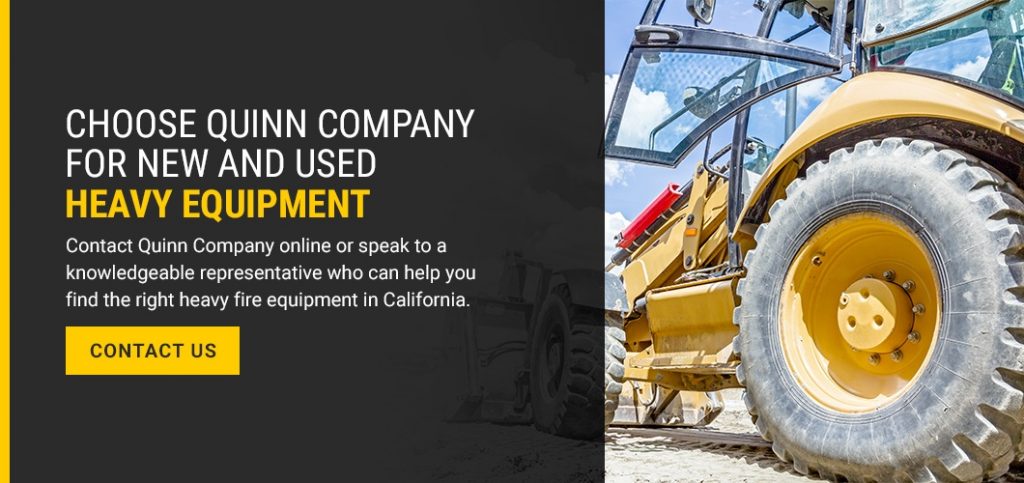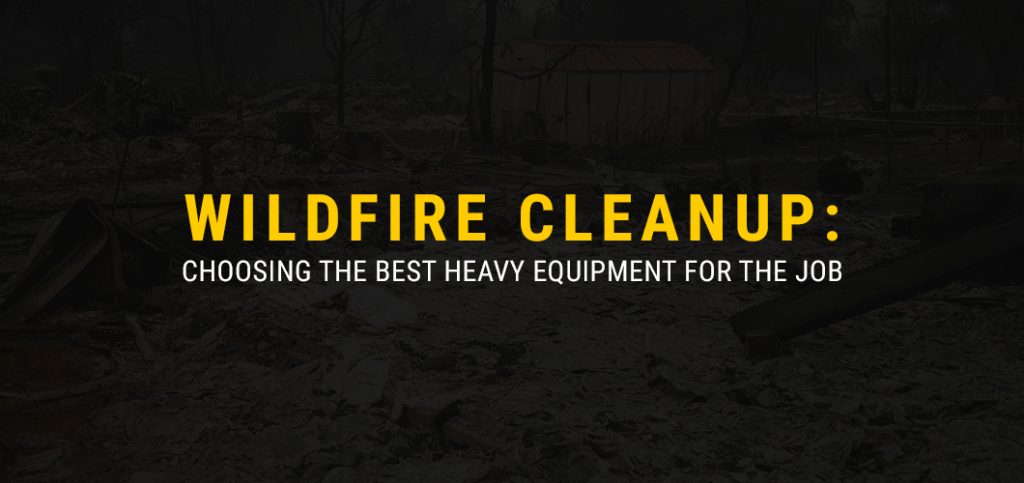
Wildfire cleanup can be a dangerous and demanding job, but it can also be performed quickly, effectively and safely with the correct heavy equipment. From dozers and excavators to loaders and forest machines, various machinery can help clean up wildfires.
Having a range of heavy fire equipment allows operators to clear large swaths of land easily to create firelines, remove burnt materials and restore the environment after a wildfire. There are many variations, including size and power, so explore all your options to ensure you select the appropriate piece of equipment to meet your needs.
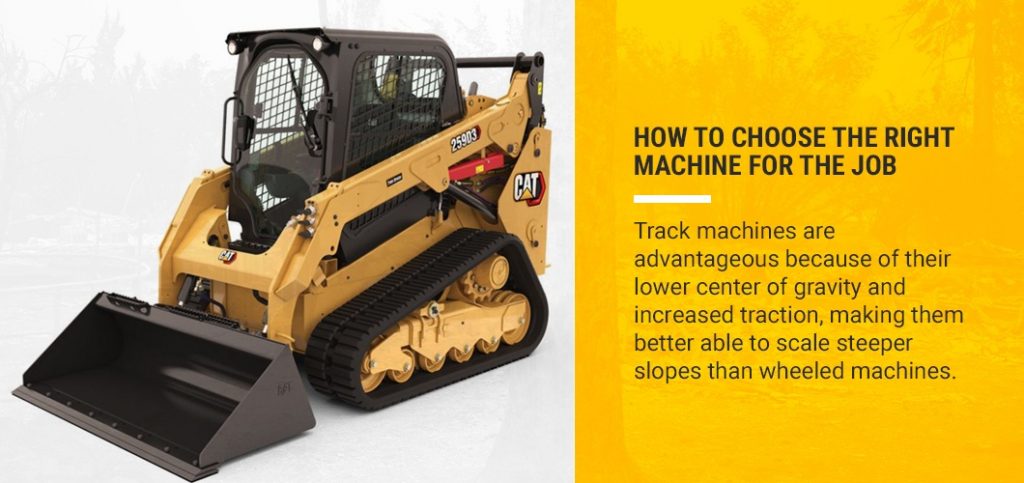
How to Choose the Right Machine for the Job
Choosing the right heavy equipment for wildfire cleanup depends on the following factors:
- Terrain
- Space and equipment maneuverability
- Location of cleanup
The terrain is a significant consideration during wildfire cleanup because equipment such as loaders and excavators come with either tracks or wheels. Track machines are advantageous because of their lower center of gravity and increased traction, making them better able to scale steeper slopes than wheeled machines. On the other hand, machines with tires are typically quicker, meaning they can travel longer distances on public roads and don’t require transportation between sites as frequently as track machines.
The softness of the terrain is also a consideration when choosing either track or tire equipment. Tracks distribute the machine’s weight over a larger footprint, so they can drive on softer ground without sinking in and getting stuck. Wheeled machines are more likely to sink into mud and get stuck.
You’ll need to define the scale and scope of your wildfire cleanup efforts before you can know which size and type of machine you will need. Larger engines are more powerful, meaning they can move more material quicker. The drawback of the size and power is weight and dimensions — heavier machines tend to sink into the softer ground, even when equipped with tracks. Larger machines also can’t enter and operate in tight spaces as smaller machines can.
If you’re operating in more open areas with lots of room and the scale of your cleanup is large parcels of land, then a larger, more powerful piece of equipment might be right for you. However, if your wildfire cleanup is done among dense forests, residential areas or on softer terrain, a smaller machine will likely better suit your needs.
It’s always a good idea to get the help of an experienced heavy equipment professional when selecting a piece of equipment. These professionals can make recommendations for your particular application.
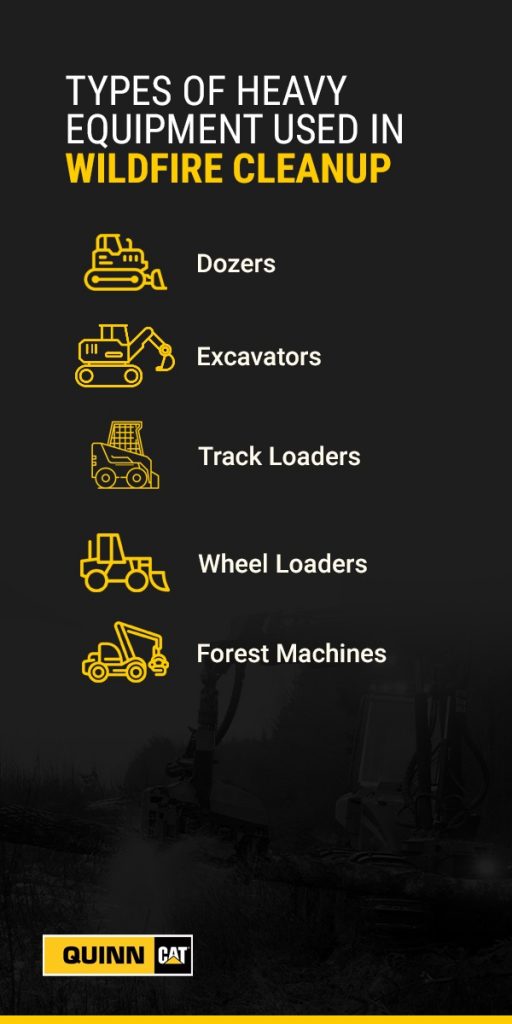
Types of Heavy Equipment Used in Wildfire Cleanup
Wildfire cleanup is a dangerous and dirty task. After a wildfire has burned through an area, it leaves a path of burnt or burning material, structurally unstable buildings and trees, pools of water used to fight the fire and an array of dangerous items such as broken glass and metal, uneven ground and the potential for electrocution.
Using heavy equipment for fighting wildfires enables workers to maintain a greater distance between themselves and the dangers present after the fire. It also allows crews to perform their cleanup tasks more quickly and efficiently than by hand.
Many of the heavy equipment types used in the forestry sector can clean up after a forest fire. Some of the machinery includes:
- Dozers to push large amounts of debris out of the way and clear a path
- Excavators to dig up buried materials, clear paths and remove debris
- Track loaders to clear paths on steeper or softer terrain and remove debris
- Wheel loaders to travel quickly around a large area, clearing pathways and removing debris
- Forest machines to clear areas of burnt trees or make a path through the forest
These machines are each made for a specific task and can dramatically improve your ability to clean up an area that a wildfire has burned.
1. Dozers
Dozers are an essential piece of heavy equipment used to clean up wildfires. Dozer drivers typically work in teams along with other support personnel.
The primary function of dozers in a wildfire setting is to create a “fireline” around the fire to stop its advancement. This is usually accomplished with three dozers. The first dozer establishes a path through, the second dozer pushes fallen trees and debris aside by running up beside the first dozer’s path, the third dozer then follows the first dozer’s path and scrapes the soil down to the mineral soil level. This creates a barrier that wildfires cannot easily jump over.
When selecting a dozer for wildfire fighting operations, make sure it has the modifications necessary for it to operate in a wildfire environment. Some of these modifications include:
- Protective radiator grills
- Overhead protection for the operator
- Undercarriage protection
Lighter dozers, such as the Cat® D5, are better in the softer ground due to their low ground pressure.
2. Excavators
Excavators are another essential cleanup tool after a wildfire. With their boom arm and bucket, their versatility is unmatched. They can also create a fireline, similar to a dozer, although they are typically not as efficient.
When it comes to burned structures or vegetation, excavators can easily tear down ruined structures or dig up burned-out stumps. They can also chew up materials to make them a better size for transportation.
Excavator sizes, weight and power options vary considerably, so it’s essential to know the specific application your excavator will be used for. Excavators with a hydraulic arm and bucket are ideal for a wildfire operation. Smaller excavators such as the Cat 313 are ideal for situations that require small physical size and lighter weight, such as in areas with soft ground or mountainous terrain where rock features make access with a larger excavator impossible. Medium and large size excavators provide more power and capability to lift heavier objects, dig deeper holes and crush tough materials.
Generally, in wildfire cleanup, larger excavators such as the Cat 323 are preferred because the wide-open spaces permit larger and heavier excavators access and operation.
3. Track Loaders
Track loaders combine the pushing power of a dozer with the convenience of a liftable bucket. This can be extremely useful in wildfire cleanup situations where you need to remove large amounts of material or when clearing sites of burned homes.
Larger track loaders such as the Cat 973K can unearth large objects such as burnt-out tree stumps or structural building material. They can also scrape away soil layers to remove any earth that might contain burnt materials.
The benefits of tracked loaders in post-wildfire environments include the ability to scale steeper slopes and traverse softer terrain than their wheeled counterparts. Tracked loaders are also used near home sites where debris such as nails make it difficult to use wheeled loaders. The tracked loader’s primary tradeoff is slower speed than wheeled machines, which means they need to be transported to sites via truck and trailer.
4. Wheel Loaders
Wheel loaders have one significant advantage compared to track loaders, and that is speed. Wheel loaders can travel more quickly than tracked loaders, making them ideal for longer travel distances with materials. Wheel loaders are ideal in a clean underfoot environment, free of a lot of debris. Also, wheel loaders can drive on public roadways, provided they are insured, which makes them extremely versatile for wildfire cleanup.
Wildfires often affect large areas of land, and therefore cleanup efforts require equipment to operate over a large area. Wheel loaders can traverse terrain quickly, enabling them to be used in many different locations without having to be transported by trailer.
The Cat 962M wheel loader can travel at speeds up to 24.5 miles per hour, so it can drive on public roads with minimal disruption to traffic or emergency services.
5. Forest Machines
Forest machines use the following attachments that perform essential work in the forestry sector:
- Felling heads
- Processing heads
- Waratah heads
- Log and fork grapples
Felling heads are attachments that allow the operator to grab a tree in the grabbing arm and then activate a cutting blade to cut down the tree. With the tree in the grabbing arm, the forest machine can then transport it to a collection area.
Processing heads operate similarly to felling heads with the added operation of processing the tree after it cuts the tree down. Processing involves feed rollers, which slide the tree through the head, where delimbing knives cut off branches along the stem. Once the tree has been fed through the processing head, a bar saw then cuts the tree at the operator’s discretion, allowing the cleaned stems to be the uniform length for transportation.
Forest machines are an essential tool in the forestry industry, increasing productivity and safety dramatically. During wildfire cleanup, forest machines can remove burnt or dead trees and process them for removal.
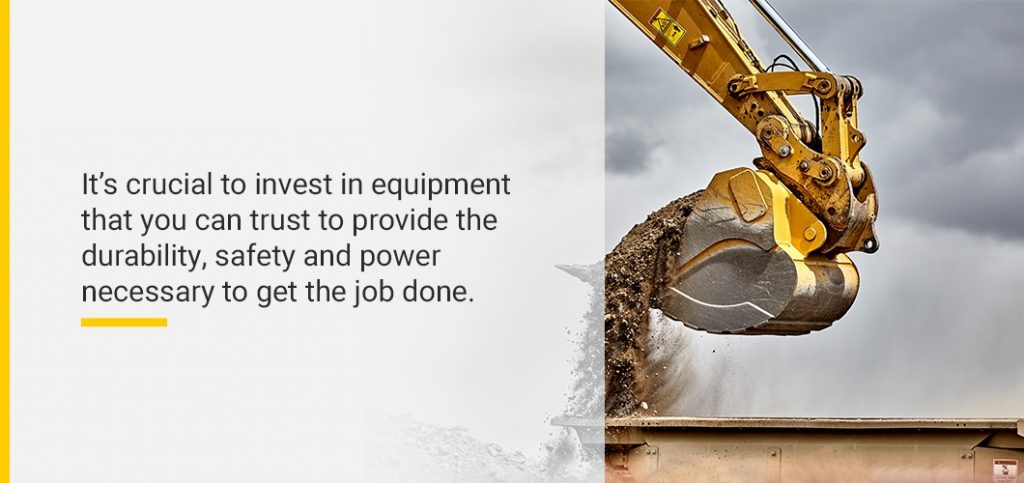
Save on Cat Firefighting Machines
Members of the National Wildfire Suppression Association can save up to $2,750 on qualifying Cat machines and up to $250 on qualifying Cat attachments.
Professional wildland fire contractors can save on skid steer loaders, compact track loaders, compact and medium wheel loaders, mini excavators, medium and large excavators, backhoe loaders, dozers and telehandlers if they are members of the National Wildfire Suppression Association.
Not a NWSA member yet? Click here to sign up.
Contact your Quinn sales representative for full offer discounts, details, and restrictions.
Why Choose Cat® Equipment to Fight Wildfires?
When choosing equipment to fight wildfires or clean them up, it’s vital to realize the inherent danger of the task at hand. In 2020, wildfires in the U.S. burned more than 10.3 million acres. In California alone, wildfires burned 4.2 million acres, killing more than 30 people and destroying 10,500 structures.
Wildfires pose an inherent risk to human lives and property, which means we must take as much care as possible when determining which tools and equipment we will use to fight or clean up wildfires.
When it comes to heavy equipment for firefighting, there’s only one manufacturer with a proven track record of equipment quality that operators and owners have come to depend on. Caterpillar is the largest equipment manufacturer globally, designing and building the most sophisticated and durable machines people rely on every day to complete their projects. Cat heavy machinery is available in a wide selection of sizes that can meet your needs and keep your crew safe when it comes to wildfire cleanup.
Operating heavy equipment in wildfire zones is extremely dangerous. That’s why it’s crucial to invest in equipment that you can trust to provide the durability, safety and power necessary to get the job done. Since 1925, Caterpillar has been a staple in the heavy equipment industry, tackling industrial problems and applying creative solutions to overcome them. It makes perfect sense to invest in the best to keep your projects moving forward and your crew safe in wildfire situations.
Safety Tips and the Importance of Operator Training
Wildfire cleanup requires operator competence when operating heavy fire equipment and adequate safety precautions to make sure everyone can perform their job properly and safely. When operating in wildfire areas, you need to ensure a few safety precautions, including:
- Adequate air supply
- Safety from falling objects
- Protection from burns or electrocution
Wildfires can reduce the structural integrity of everything they contact. From trees to buildings, the risk of collapsing or falling objects is significantly increased once a fire has passed through. To reduce the risk of injury and equipment damage, take measures to protect the machine’s sensitive components and the operator cabin from damage due to falling debris. Some of these measures include:
- Adding guarding to protect critical components
- Reinforcing cages around the operator cabin, especially in front of any glass or plexiglass
During a wildfire, fire crews use large amounts of water to put out the fire, leaving puddles of water that can act as an electrical conductor. In areas with electrical service, this can pose an extreme danger of electrocution to cleanup crews and equipment operators. To reduce this risk, ensure the appropriate authorities have turned off electricity before you access the area. Always be on the lookout for power lines above or below, and avoid ground-level transformer stations that might be hidden by fallen debris.
Competent equipment operators are the foundation of a successful and safe cleanup effort after a wildfire. To ensure heavy equipment safety on wildfires, enroll your operators in operator competence and safety training so they are up to speed in all areas of safety and correct operation of their equipment.
Choose Quinn Company for New and Used Heavy Equipment
When it comes to Cat equipment sales and rentals in California, look no further than Quinn Company. Since 1919, Quinn has provided superior service and quality Cat products to equipment operators, contractors and government services. With a wide range of equipment selection and extensive product knowledge, we pride ourselves on being an ally to your business.
Wildfire cleanup is a high-stakes industry with many variables, but with Quinn Company’s excellent service and sales expertise, you are that much better equipped to tackle the job. Quinn Company has 19 locations throughout Southern California, making our team well situated to supply you with maintenance, repairs and sales, wherever your project locations.
Contact Quinn Company online or speak to a knowledgeable representative who can help you find the right heavy fire equipment in California. Give us a call at 1-888-987-8466.


